Dickinson is proud of its history as the 16th-oldest college in America and the first chartered in the newly recognized United States (after the signing of the Treaty of Paris). Tradition is part of our foundation, and many traditions remain relevant in our narrative today.
Signing in/signing out
Each year, new Dickinsonians gather in front of Old West's venerable stone steps. Literally etched with history and scuffed by centuries of students, those steps are part of Dickinson's most important traditions.
During Convocation, new students walk up the steps , through the doors into Memorial Hall and sign into the college. The doors of Old West symbolize Dickinson's connection to its past and a gateway to the future.
At Commencement, the graduating class walks out the doors and down the steps, symbolically exiting the college and entering the world of alumni.
Seal
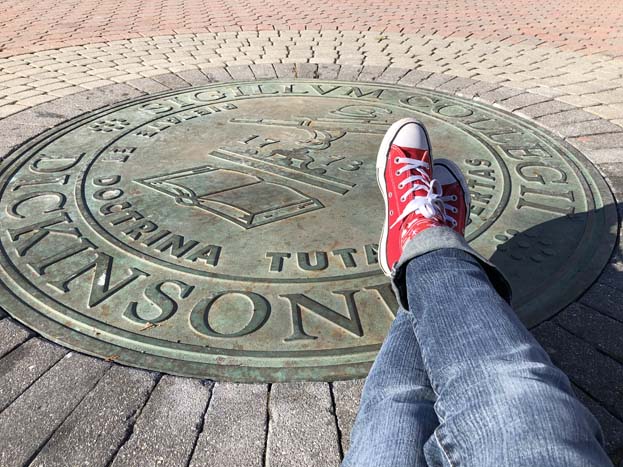
In the summer of 1784, as the college's founders discussed the formation of the college, Benjamin Rush and John Dickinson were asked to create a suitable seal for the institution. The resulting seal consists of an open bible, a telescope and a cap surrounded by the inscription "Pietate et Doctrina Tuta Libertas," a Latin phrase meaning "Freedom is made safe through character and learning."
The open bible represents freedom of access to religion. Similarly, the cap, modeled after the liberty cap of the Sons of Liberty, symbolized independence of political activity. The telescope indicates earnestness in intellectual endeavors.
Watch your step! Legend has it that if a student treads on the college seal embedded in the middle of Britton Plaza, he or she won't graduate.
College Colors: Red and White
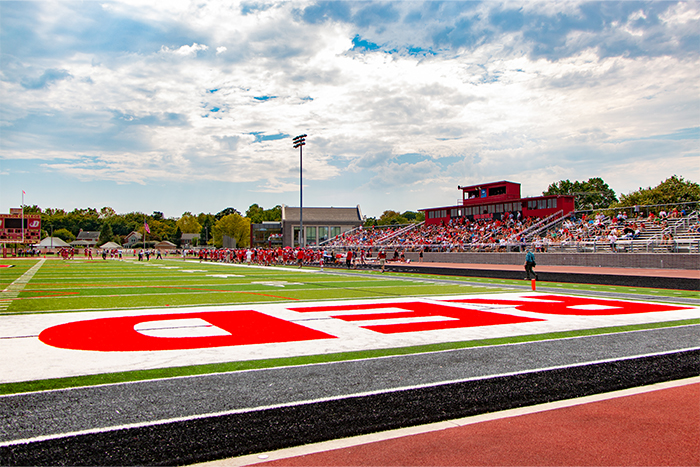
The Belles Lettres Society was founded at Dickinson College in 1786. The Union Philosophical Society (UPS) was established three years later. These two literary societies established their own symbols—a red rose for Belles Lettres and a white rose for UPS.
By the 1880s, when intercollegiate athletics were becoming a part of campus life, these two literary societies already had been around for a century. Their members and their traditions were thoroughly woven into the fabric of the college’s history. It seems quite natural, then, that their symbolic colors would come to define Dickinson.
In 1900, Horatio Collins King, class of 1858, published Songs of Dickinson, which included several references to the school colors. Most notable among them is “The Red and White,” set to the tune of “Battle Hymn of the Republic.” Several red-and-white pennants from that same time period are carefully preserved in the archives vault, further evidence that the school colors were well established by the turn of the 20th century.
Global street sign
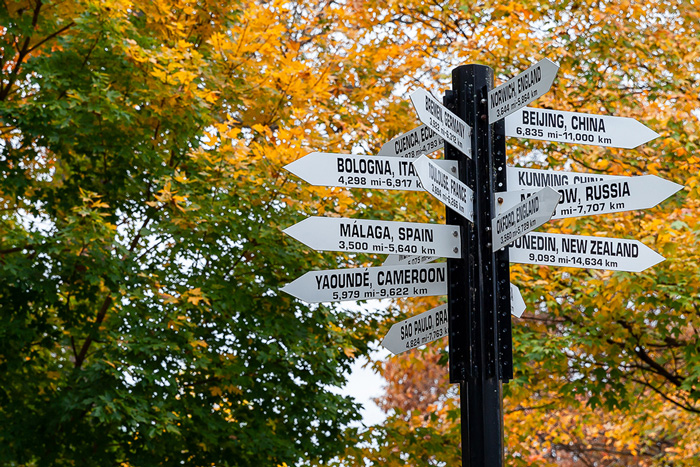
Instilled with an international spirit by Dickinson's founder Benjamin Rush, the college was destined from the beginning to be a leader in global education. Rush advocated the teaching of modern languages and the integration of an international perspective in the curriculum.
By the mid-1960s, Dickinson had alumni living all over the world. With a vast, global network, Dickinson created a truly internationalized campus.
The directional sign located in front of Old West shows these global connections by pointing to Dickinson centers around the world.
Mermaid
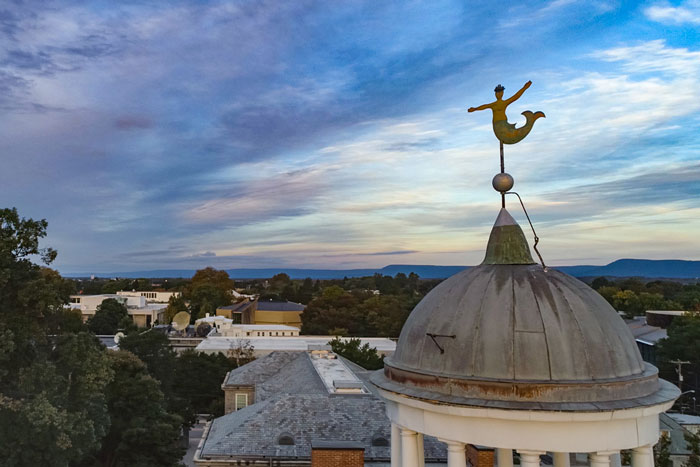
As Benjamin Latrobe designed Old West on Dickinson's campus, he was instructed to include a cupola for a bell. After consulting his text on Greek architecture, Latrobe decided to model the cupola loosely on the Athenian Tower of the Winds. To further this association, Latrobe ordered a likeness of Triton, the fish-tailed mythological god of the sea, to be placed atop the cupola as a weathervane.
It was the ensuing confusion of the local coppersmith that provided Dickinson with its most famous icon. The coppersmith crafted instead the only fish-tailed human with which he was familiar—a mermaid.
The mermaid quickly captured the heart of Dickinson students and inspired a series of legendary pranks. For more than 100 years, students would steal the mermaid from its perch and, after a time, return it for the benefit of future classes. During this series of friendly heists, Dickinson's president at the time decided to remove this battered but priceless relic from the cupola for its protection.
The original mermaid is now on display in Dickinson's library while a replica has taken its place on Old West. Dickinson's theatre troupe, the Mermaid Players, fashioned its name after this famous campus icon.
Take a Seat
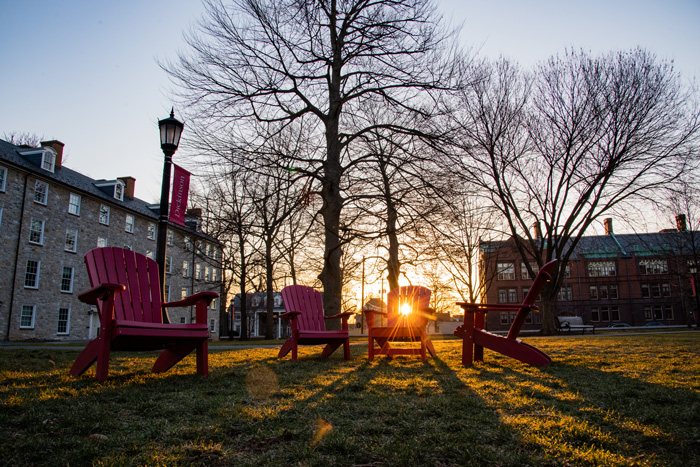
There are several spots on campus that are known as gathering places for Dickinsonians. The red Adirondack chairs, a highly visible part of the campus landscape, are never in the same place from one day to the next. Students move them to a quiet place to study alone, classes arrange them in large circles for active discussions and friends put them side-by-side to sit and watch life on campus.
Another popular outdoor space is Morgan Rocks, a natural rock formation in the residential quad that is the perfect meeting space.
Indoors, the cushies are the plush, comfy couches in the main area of the Holland Union Building. Students can be found there at all hours, in large and small groups, either relaxing, studying, holding a meeting or just watching the passersby.
Noble Dickinsonia!
Alma mater written by Horatio Collins King, Class of 1858, who also wrote, "Dickinson for Aye!" and "Those Lovely Carlisle Girls." The first verse of lyrics, sung at major college events are:
Alma Mater, tried and true
Noble Dickinsonia,
Oft our hearts shall turn to you,
Noble Dickinsonia,
How each ancient classic hall,
Fondest mem'ries will recall,
Sacred is each gray old wall,
Noble Dickinsonia.
Devil May Care
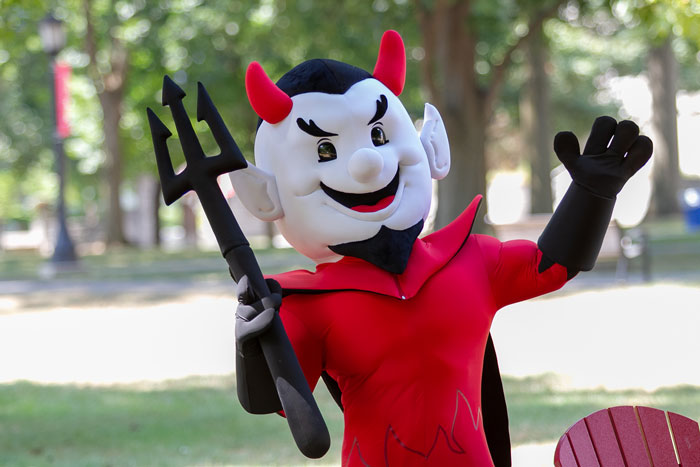
Dickinson's Red Devil mascot emerged in 1930, when the football team played a tough game against George Washington University. Because of their show of grit and spirit against a superior team, a Washington writer from the Public Ledger dubbed the Dickinson team "the Red Devils." Students took to the name, and a mascot emerged. And in 2019, the costume was updated to better reflect the distinctive graphic identity that had been established for the Red Devil. Learn more and download the Dawn of the Red Devil coloring book.
Many years later, as campus sustainability became a hot topic at Dickinson, another mascot was developed—the Green Devil. One might call him the Red Devil's environmentally conscious cousin.
Homecoming & Family Weekend
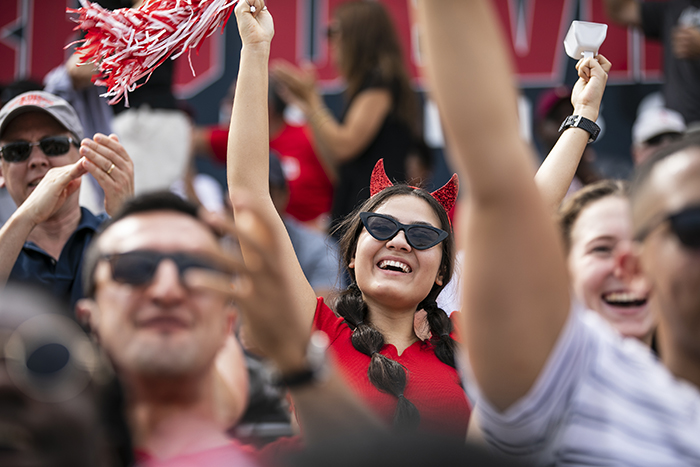
Homecoming & Family Weekend is an annual event that brings together the Dickinson community for a few days of fall fun. Homecoming also is a time for the current student body to boast their latest advancements in academia and athletics.
Festivities include the Red Devil football game, lectures and presentations, tours and receptions and family friendly entertainment.
Football Feuds
The Dickinson Red Devils and the Franklin & Marshall Diplomats began their football rivalry in 1889, when teams traveled by horse-drawn wagons. The Conestoga Wagon is a golden model that has been exchanged between the longstanding rival teams since 1963. Theirs is the longest, most active rivalry in the Centennial Conference.
The battle for the Little Brown Bucket, which dates back to 1892, occurs between the Red Devils and the Gettysburg College Bullets. The mahogany bucket trimmed in sterling silver was donated in 1939 by Gettysburg and Dickinson trustees.
Benjamin Rush
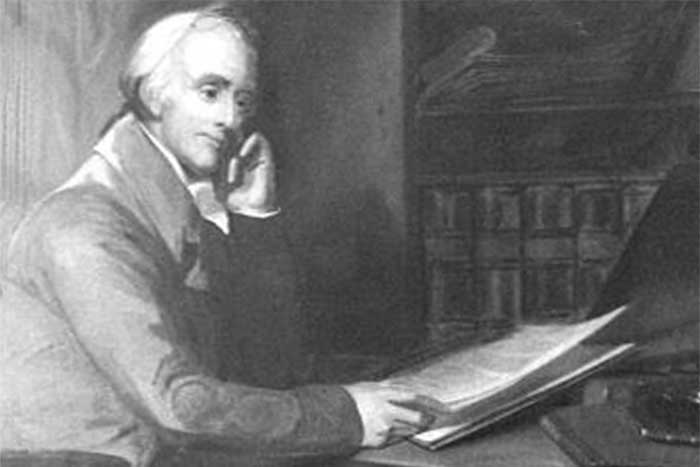
Dr. Rush, a signer of the Declaration of Independence and the foremost American physician of the 18th century, is founder of Dickinson College. He called for a Dickinson education to be bold and "forward-thinking" for a resourceful nation.
He was passionately revolutionary and fought for important causes. He is considered the founder of battlefield medicine and dentistry in America, and he argued for the humane treatment of the mentally challenged and established the first free mental-health clinic in America. Rush fought against slavery and advanced the education of women. He is considered the father of American psychiatry and was the country's first professor of chemistry.
A statue of Benjamin Rush is among the landmarks featured in Dickinson's historic triangle—the cross-section space created by Old West, the Stern Center for Global Education and East College. A reminder of the past, the statue also plays a part in current campus traditions, and students frequently garnish the statue with colorful streamers or apparel to celebrate important events such as Spirit Week or Commencement.
Debate and Honors Societies
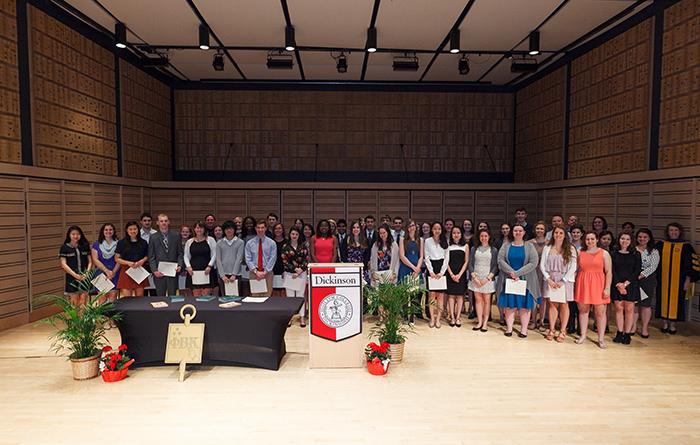
The first student organizations at Dickinson College (and among the first in America) were two literary societies, Belles Lettres Society (est. 1786) and Union Philosophical Society (est. 1789). The societies served as forums for political debate. Student life in the 19th century revolved around public debate and exhibitions that were hosted by both societies, and the societies regularly challenged each other to debate.
The official red and white colors of Dickinson College emerged from the societies' symbols. Belles Lettres adopted a red rose, while Union Philosophical chose a white rose. Today, both societies remain active on campus in addition to 130 clubs and organizations that have emerged during Dickinson's more than two centuries of history.
Honor societies are an important part of the Dickinson experience for some of our most engaged students. The college boasts a connection to prestigious national honors organizations such as Phi Beta Kappa, but also features its own societies including Raven's Claw, founded in 1896 for senior men, Scroll and Key, a local society recognizing service, leadership and personal character, and Wheel and Chain, an organization honoring senior women. Members are tapped each spring through special ceremonies.
John Dickinson's Lion
John Dickinson, the college's namesake, shed his family's aristocratic past by refusing to have a coat of arms in America. He extracted only one of its icons as a symbol-a lion. A priceless piece of the college's history, the lion, in the form of a marble sculpture, traveled everywhere with John Dickinson and was probably present while he drafted the Articles of Confederation.
Today, the lion has watched over several classes of graduating Dickinsonians at Commencement and often appears at the college's signing in ceremony.